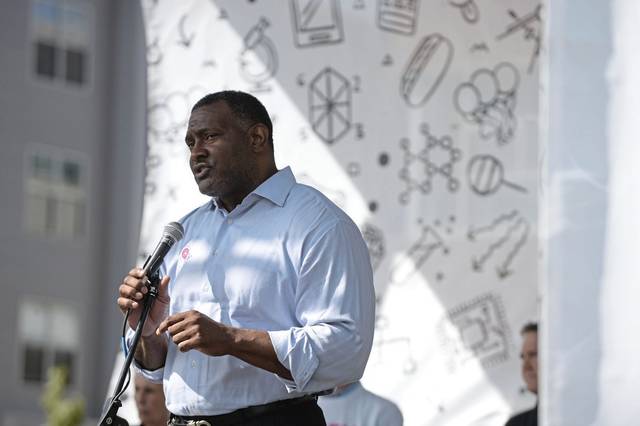Pittsburgh Public Schools announces new equity task force, lays out plans for return to buildings
Pittsburgh Public Schools on Tuesday announced the development of a new task force to recommend and influence policies that combat racial disparities in school safety.
“I can share with you with great certainty that our district will not bring Black students back to live and learn under the same racially-biased environment that they left a year ago,” Superintendent Anthony Hamlet said.
The announcement was one of many points in an hour-long update with local news media, in which district officials detailed the district’s plans and goals for 2021. The new year will include the phased return of in-person classes, the new task force and the implementation of “Imagine PPS,” the district’s five-year plan.
Hamlet said the pandemic “ripped the scabs off the inequities” that existed in the district and nationwide – compounded even more by the deaths of George Floyd and Breonna Taylor last year at the hands of police. The new task force is meant to address those inequities and reduce student involvement in the criminal justice system, often called the “school-to-prison pipeline.”
The school board had voted in September to evaluate available police data and use the information to determine measures for reducing the disproportional arrests, citations and suspensions in Pittsburgh Public Schools among students of color. That resolution charged board members to form the Re-Imagine School Safety Task Force.
Board member Devon Taliaferro, who introduced the September resolution with board member Pam Harbin, said the task force will provide the board with recommendations to influence policies and develop strategies for implementing school safety more equitably. The majority of the task force members will come from the community, and the group will include representatives from Black Girls Equity Alliance, the Pittsburgh Federation of Teachers, Latino Community Center and students and administrators in the district. The first meeting will be Jan. 27.
“Our mission and No. 1 goal,” Taliaferro said, “is to create safe, healthy and equitable schools for all PPS students.”
“This is one giant step in the right direction as we continue to move forward in the New Year,” she added.
Officials emphasized plans to “change the system intentionally,” segueing into the district’s five-year plan, Imagine PPS.
The plan will focus on five key areas, Chief of Staff Errika Fearby Jones said: student pathways, positive student experience (mental health supports, sports programs and more), strategizing for “underperforming” schools such as Perry and Westinghouse, new school and new program design and systemic improvements, which will address school funding, the district capital plan, technology enhancement and other areas.
Fearby Jones said the district will be focusing on a number of projects in just the next 90 days, including determining graduation requirements and addressing the $39.4 million budget deficit.
“Imagine PPS provides an opportunity for PPS to modernize its footprint, to accelerate student outcomes and to infuse more of what we know works for students,” she said.
Pittsburgh Public School students are still learning remotely until at least Jan. 27, which is the start of the second semester.
Any dates to resume in-person learning are tentative, Hamlet said.
The district is anticipating a surge in local covid-19 infections after Christmas and New Year’s. The same statistics that took the district into virtual learning will be used to determine when the hybrid model can be implemented, District Physician Martin Gregorio said. This could affect plans to bring students to buildings in late January.
When students and teachers do return, typical regulations like mask-wearing, physical distancing and frequent hand-washing will be in place, said Gregorio.
Students will return under the same hybrid approach that was attempted in November – starting with students considered to have the highest need, including English language learners and special needs students.
And after more than eight months without in-person learning, the district has finally achieved a one-to-one student-to-device ratio, officials announced.
“I’m happy to say, today, we have every laptop for every single one of our students in our hands,” said Chief Technology Officer Mark Stuckey.
Stuckey said the rest of the devices will be distributed to schools, which will contact families directly so they can pick devices up for students. He said all students should be in possession of a district device by the end of January.
Since shifting to virtual instruction in March, Hamlet said, the district heard from nearly 1,000 families who indicated they did not have access to the internet. The district collaborated with Comcast, the Pittsburgh Housing Authority and Neighborhood Allies to provide internet access, partnered with T-Mobile to provide around 2,600 mobile hotspots and purchased more than 22,000 laptops and more than 3,000 iPads. Those devices were repeatedly delayed in 2020, due to supply and demand issues, Hamlet said.
“Could we have gotten them sooner? I don’t think so,” he said. “We tried everything we could do.”
Even with the potential return of face-to-face instruction, teachers will spend much of 2021 and years to come dealing with the long-term effects of pandemic-related learning loss. While Hamlet said the district has a 90.7% daily attendance rate (based on log-ins to the district’s online system, Schoology), there are still around 125 students that have not been reached during the first quarter.
Even for those who have engaged in online learning, Hamlet said, students are struggling to learn away from teachers. He said the district is forming plans to address the long-term impacts, considering measures including summer school and other programs.
“We do know there will be an achievement gap and learning loss as a result of remote learning in this pandemic,” he said. “He have to begin to plan and pivot to make sure we put supports in place, to mitigate that as much as possible moving forward. … Once this pandemic is over, the lasting effects on the learning of our students will last a lifetime.”
Remove the ads from your TribLIVE reading experience but still support the journalists who create the content with TribLIVE Ad-Free.

